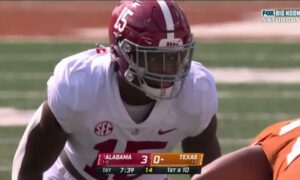By David Todd
When the NFL\’s complex passer efficiency rating was devised in 1971 it was seen as a kind of Holy Grail. In one number it unlocked the answer to the question of which quarterbacks performed best each year. As an added benefit it could be used to evaluate QBs over their careers and to compare signal callers from different eras. Although no one new exactly how to calculate it, the scale quickly became familiar to fans. It was similar to the grading scale common in high school. A quarterback posting a number above 100.0 was probably having an MVP-type season–Ivy League material. An 85.0 would put him in the middle of the pack though probably not the playoffs–easily the State U. If your QB posted a 70.0, you knew you had a dog–time to get out in the real world and find a job.
We\’ve come a long way in sports analytics since 1971. Our ability to analyze has become more precise and our metrics more complex. New statistics like DYAR and DVOA from sites like Football Outsiders began popping up, giving us a more refined, although more arcane, analysis of who was best. We came to realize that passer efficiency rating was not quite all it was initially cracked up to be. Even simple statistics like Yards/Attempt began to get more play in the discussion of evaluating who was best.
But a funny thing happened on the way to the 2010 Playoffs. The old passer efficiency rating showed that it is not quite dead as a useful tool in ranking quarterbacks. Let\’s take a look at how it rates this year\’s performances and how it ranks the top 20 quarterbacks, along with some other familiar numbers:
|
Comp %
|
Att/Gm
|
Yds/Att
|
Yds/Gm
|
TDs
|
Ints
|
Rating
|
|||
|
1
|
65.9
|
30.8
|
7.9
|
243.8
|
36
|
4
|
111.0
|
||
|
2
|
66.0
|
33.8
|
8.7
|
294.4
|
30
|
13
|
101.8
|
||
|
3
|
65.7
|
31.7
|
8.3
|
261.5
|
28
|
11
|
101.2
|
||
|
4
|
62.6
|
31.0
|
8.1
|
251.5
|
21
|
6
|
100.2
|
||
|
5
|
61.7
|
32.4
|
8.2
|
266.7
|
17
|
5
|
97.0
|
||
|
6
|
61.4
|
29.6
|
7.3
|
215.7
|
25
|
6
|
95.9
|
||
|
7
|
62.6
|
30.6
|
7.4
|
226.4
|
25
|
10
|
93.6
|
||
|
8
|
58.2
|
30.0
|
6.9
|
207.7
|
27
|
7
|
93.0
|
||
|
9
|
63.6
|
35.9
|
7.6
|
273.1
|
24
|
12
|
92.0
|
||
|
10
|
66.3
|
42.4
|
6.9
|
293.8
|
33
|
17
|
91.9
|
||
|
11
|
62.5
|
35.7
|
6.5
|
231.6
|
28
|
9
|
91.0
|
||
|
12
|
68.1
|
41.1
|
7.0
|
288.8
|
33
|
22
|
90.9
|
||
|
13
|
64.5
|
26.1
|
7.5
|
195.3
|
23
|
15
|
90.8
|
||
|
14
|
65.7
|
31.8
|
7.4
|
236.5
|
16
|
12
|
88.9
|
||
|
15
|
58.8
|
38.3
|
7.3
|
281.0
|
20
|
9
|
87.5
|
||
|
16
|
60.4
|
28.8
|
7.6
|
218.3
|
23
|
16
|
86.3
|
||
|
17
|
62.9
|
33.7
|
7.4
|
250.1
|
31
|
25
|
85.3
|
||
|
18
|
59.0
|
25.3
|
7.3
|
183.6
|
13
|
8
|
84.5
|
||
|
19
|
61.8
|
36.6
|
6.8
|
248.1
|
26
|
20
|
82.4
|
||
|
20
|
57.6
|
27.8
|
6.6
|
182.3
|
14
|
8
|
82.2
|
||
What Stands Out:
Passer efficiency rating is a reasonably useful aggregate number when generally sifting through quarterback play, particularly this past season. Manning and Brees had slightly subpar seasons versus their Super Bowl season from a year ago and Josh Freeman is probably much better than the average fan realizes. Otherwise there isn\’t a lot that is surprising in the numbers or the rankings.
1.) 9 of the 12 highest rated QBs made the playoffs. The three who didn\’t were #2 Phillip Rivers whose Chargers went 9-7, #6 Josh Freeman of Tampa Bay who lead his team to a 10-6 record and #9 Matt Schaub who\’s team went 6-10 largely because of a historically bad pass defense.
2.) The three QBs whose teams made the playoffs but did not finish in the top 12 were #16 Jay Cutler of Chicago, the most enigmatic and reckless, now that Favre has retired, quarterback in the league, #27 Mark Sanchez who had an abysmal 54.8% completion percentage and #28 Matt Hassleback of Seattle whose team finished 7-9, with all of their losses coming by 15 points or more.
3.) Tom Brady is clearly the NFL MVP. But, this is one place where the rating system does not give us the whole picture. Passer efficiency is what it says it is. Passer efficiency rating. It does not take into account a quarterback\’s value in running the ball. In this respect there is no doubt that Mike Vick has tremendous value versus virtually every other quarterback in the league which is not measured by the rating number. The number does show us what a fantastic year Brady had throwing the ball in relation to all other quarterbacks, but it also tells us that Vick had an excellent year as well. So do Vick\’s running numbers (100 attempts, 676 yards, 9 TDs) make up the difference? Yes, they are valuable, but no. The problem is Vick only played a little over 11 games, while Brady played all 16. The rating number is not a counting stat and the fact that Vick missed over 25% of the season means his number is inherently less valuable because it comes from a smaller sample size. An excellent year for Vick, but an easy decision. Tom Brady was the best quarterback in 2010 and will surely win the MVP.
It probably isn\’t time to discard the QB rating number. Sure it has some flaws, but I\’m not sure we\’ve still come up with one metric that quickly captures and reasonably evaluates quarterback play that is more uesful and easily understood. Our analysis does keep getting better, but sometimes the old familiar numbers still tell a good story. And it sure tells us that good quarterback play goes a long way toward getting a team in the playoffs.
Read more from David Todd at his Hammer Speaks Blog and follow him on Twitter at @hammerspeaks.







